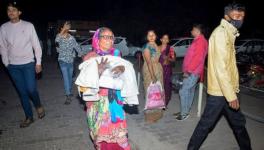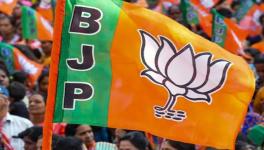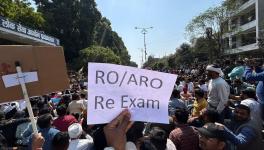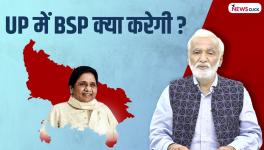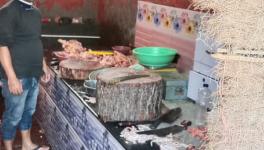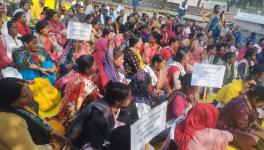Let's Not Forget the Children of Gorakhpur, While Celebrating 7 Decades of Independence
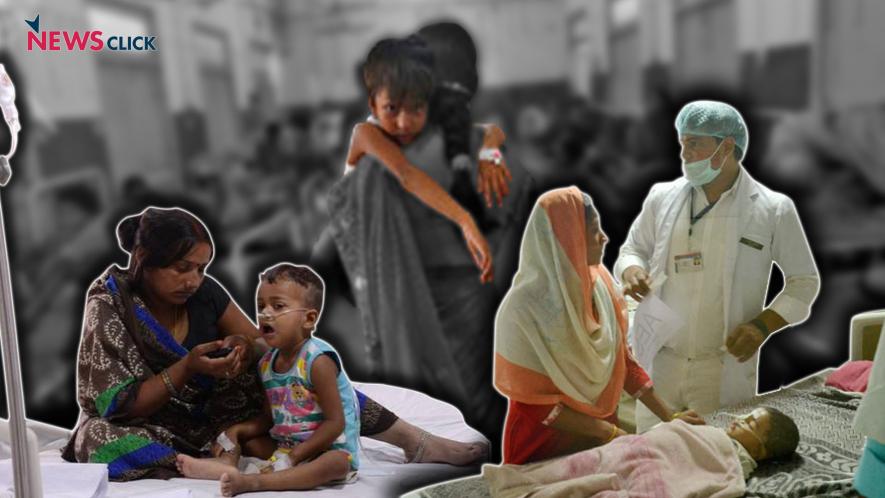
Newsclick Image by Nitesh Kumar
Seventy years of independence, in normal circumstances, should call for celebrations across the nation. Unfortunately these are not normal times. For once we hoped that even this government, hard wired to proclaim its nonexistent ‘achievements’ in strident tones accompanied by incessant jingoist chest thumping, would have considered shedding a few tears for the children of Gorakhpur who did not live to see their country celebrate its 70th year after independence. Alas that was not to be – the children of Gorakhpur, we were informed from the ramparts of the Red Fort, were victims of a ‘natural calamity’.
Rudolph Virchow, the 19th century German pathologist had famously remarked “It is the curse of humanity that it learns to tolerate even the most horrible situations by habituation.” A nation that is prepared to accept this calamity as ‘natural’ is truly cursed. That the deaths occurred in the parliamentary constituency of the BJP’s poster boy of nationalism compounds the enormity of the crime. For a crime it is, when callous disregard for the well being and welfare of the most vulnerable, results in the loss of lives that could have been saved. Possibly it is the enormity of the crime that has triggered the massive cover up mounted by the government, both in Lucknow and Delhi.
All that is wrong with public health
Why did the children have to die? The answer to that question leads us through a trail that epitomizes all that is wrong with healthcare services in India. Collectively, as a nation, we have failed to even recognize that access to healthcare is a fundamental right. Not just for those who can buy expensive care in the market, but for all citizens. As a nation we have remained silent while healthcare has been reduced to a commodity that is to be purchased in the market, while successive regimes have converted public health services into a mockery. As a nation we have failed while huge chunks of public facilities have been handed over to private providers.
The facts speak for themselves, so let us recall the back story. UP (East UP is particular) is one of the worst performing states in terms of health infrastructure. While the state’s population has risen by 25% in the last 15 years, the number of public health facilities has fallen by 8%. In Gorakhpur district, only 90 of 120 primary health centres (PHCs) are functioning and of these more than a quarter are virtually non functional due to extreme shortage of facilities.
The Baba Raghav Das (BRD) Medical College Hospital -- where over 70 children died within 3 days since August 10th -- is the only tertiary hospital in the region with a bed strength of 955. It caters to the needs of specialized care in 15 districts of East UP and also receives patients from neighboring Bihar and Nepal. The hospital receives over 6,000 patients every day in the monsoon season when there is a steep rise in the incidence of various illnesses.
The scourge of encephalitis
The hospital is clearly over crowded, under staffed and under resourced, leading to an inordinately high number of deaths in the hospital. The hospital has a budget of just Rs. 5.32 crore for medicines, which works out to just Rs.150 per bed per year. Till July 2017, of the 2,386 new born children admitted to the hospital, 931 died. Media reports indicate that in the pediatric ward (children’s ward) 3-4 children share one bed. Being the only specialty hospital in the region the hospital has been identified as the principal centre for treatment of encephalitis – a severe life threatening disease that mainly affects children and is characterized by a swelling of the brain. Those affected can become unconscious, be delirious, and have seizures. There is no particular medicine to treat the condition and patients need to provide supportive care, with the hope that the child will eventually recover when the swelling in the brain goes down due to the body’s own defence and self correcting mechanisms. Most children, if provided good supportive care, do survive. Supportive care should include artificial methods of feeding (usually inter-venous) and provision of oxygen as the brain is starved of oxygen.
Encephalitis can be caused by a number of infections as well as by toxins. It can also be caused in neonates (infants less than one month old) by birth related problems which can lead to the brain being starved of oxygen or in infants in whom the liver is not functioning properly in the first few days after birth. Typically those affected are premature babies, low birth weight babies and those born after a prolonged and difficult labour. The most documented cause of infective encephalitis is Japanese Encephalitis (JE) caused by the Japanese Encephalitis Virus (JEV), which is spread by mosquitoes, and which incubates in pigs and birds. The association with pig rearing led to epidemics of JE in Japan, Singapore, Taiwan and Korea in the past, but the disease has been largely contained in these countries after the introduction of an effective vaccine between 1960-1980.
In India infective encephalitis is also known to be caused by a different class of viruses (enterovirus) that spread through contaminated drinking water. Recently it has been established that several older children who suffer from encephalitis are affected by a toxin present in the unripe litchi fruit. The toxin seems to only affect malnourished children. In the monsoon season the conditions for the spread of all the infective and toxic varieties of encephalitis are pronounced – more breeding sites for mosquitoes, contamination of drinking water with sewage, availability of toxic fruits, etc. – and explains the rise in the incidence of encephalitis between July and September. Every year thousands of children in the Gangetic plains of India are affected by encephalitis and about a thousand of them do not survive. UP sees the largest number of such cases and deaths. These figures are based on recorded data, and the actual number is likely to be 2-5 times higher.
When hundreds of children were lest gasping
So what happened in the BRD hospital on the night of 10th August that was different? All the contributory factors related above, leading to high load of very sick infants and children, existed in the pediatric ward. The situation was compounded by a sudden disruption in the supply of oxygen by the private company that had been contracted to supply it to the hospital. Reports suggest that the hospital owed the company Rs.70 lakhs for several months and the contractor had earlier threatened that it would stop supplies. Evidence is also emerging that the non-payment is linked to several factors – reluctance in Lucknow to release payments, possible links with conflict with the company over kickbacks, as well as bureaucratic apathy and callousness.
The immediate effect was that the disruption of oxygen proved fatal for scores of infants who were already in an extremely fragile situation. Stories in the media talk about how parents were asked to keep pumping air into their children using an ambu bag (a bag like a football bladder that is used as a temporary measure when oxygen is not available) for hours till their hands went numb.
Where have we failed?
So how did we fail the helpless children, many of whom would have ordinarily survived? First, we failed to develop a functioning infrastructure of public healthcare services in the region – one specialty hospital for fifteen hospitals is a pathetic joke, especially when most other health facilities just do not function. We failed to conduct proper epidemiological studies to be able to forecast the precise nature of the annual encephalitis epidemic in the region. While a vaccine for at least the JE virus has been available for decades, it was never deployed effectively. We allowed the conditions to fester – from mosquito breeding to poor sanitation -- that allowed transmission of the infection causing viruses. These seasonal factors were augmented year after year by the birth of too many children with low birth weight and other birth related complications, because our mothers are too frail, too young, and our public health services provide almost no support. We failed because of our belief in the inherent efficiency of the private sector when a vital element of hospital care -- oxygen supply – was outsourced to a private contractor.
Above all, our greatest failure is the unwillingness to take responsibility for a human tragedy of enormous proportion and to want to pass it off as a ‘natural calamity’. The spin doctors are busy churning out data to try to prove that deaths due to encephalitis have actually come down in the region! UP holds the distinction of having introduced ‘cow ambulances’ each with the service of a qualified veterinary doctor. If only the children, who didn’t survive the dark nights before our 70th independence day had been offered similar treatment, many of them might still be alive. Yes this was a ‘natural calamity’, but only because we live in unnatural times. A nation of proud people is compelled today to hang its head in shame because, in the ultimate analysis, we failed to protect those who needed our care.
Disclaimer: The views expressed here are the author's personal views, and do not necessarily represent the views of Newsclick.
Get the latest reports & analysis with people's perspective on Protests, movements & deep analytical videos, discussions of the current affairs in your Telegram app. Subscribe to NewsClick's Telegram channel & get Real-Time updates on stories, as they get published on our website.










